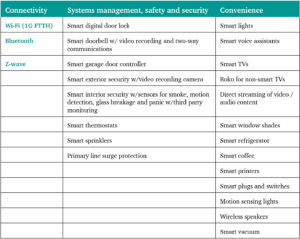
Using his own experience planning and integrating a Smart-home, John Denslinger, is looking forward to new device compatibility technology due in 2022.
Forty years in the electronics industry and still fascinated by innovative technology: how great is that? So, when I decided to build a new house in 2021, I knew it had to be Smart. Typically, I wouldn’t expound on a personal activity, but the experience produced some real eye-openers worthy of honest, technical discussion.
Planning a Smart-home was easy, integrating one was not. The market is flooded with products covering every imaginable function and under-estimating the importance of brand selection caused more than one false start. User set-ups were needlessly difficult and I quickly recognized compatibility was a big problem. Meshing with other devices was trial and mostly error. Adding another smart function—plan on buying another device. Then there was the burden of managing a multitude of apps. A typical Smart-home may require 15 or more apps for functional control, monitoring or basic information. At this stage of implementation, my Smart-home eco-system involves 12 apps. For perspective, here is a breakdown of devices currently in-play:
Homeowners, like myself, see AI technology saving energy, saving time, increasing both comfort and convenience in daily living. This was also the conclusion of a 2021 Smart-home study by LG ThinQ. While early adopters tended to be techies, the work-from-home movement really transformed Smart-home into a mainstream need. With that said, there remains much to improve upon, particularly device compatibility and system complexity.
Why is it a matter of time? If all goes well, a much-needed breakthrough will occur in 2022: a common language protocol. Smart-home devices will be able to communicate with each other regardless of brand. The initiative is being championed by Apple, Amazon, Google, Samsung, and other well-known companies who recognize the tremendous value of creating a common platform for Smart-home growth. The new standard is named Matter. Matter will simplify installation. Adding Matter-compatible devices to your network might be as easy as scanning QR codes. Matter is designed to work with minimal internet dependence thus offering faster response times while assuring greater privacy and improved security.
Smart-home products bought within the last few years are said to work with the new standard, but anything older, plan on replacing. One additional caveat mentioned dealt with complex products like cameras and appliances. These are not expected to sync initially. One could say: ‘that’s the price of innovation’. As a cost-sensitive consumer though, that news is quite disappointing.
Matter is the missing link to faster Smart-home adoption. ABI Research seems to concur predicting 5.5 billion Matter-compliant Smart-home devices shipped by the end of this decade. That’s huge. Smart-home…it’s a Matter of time.

